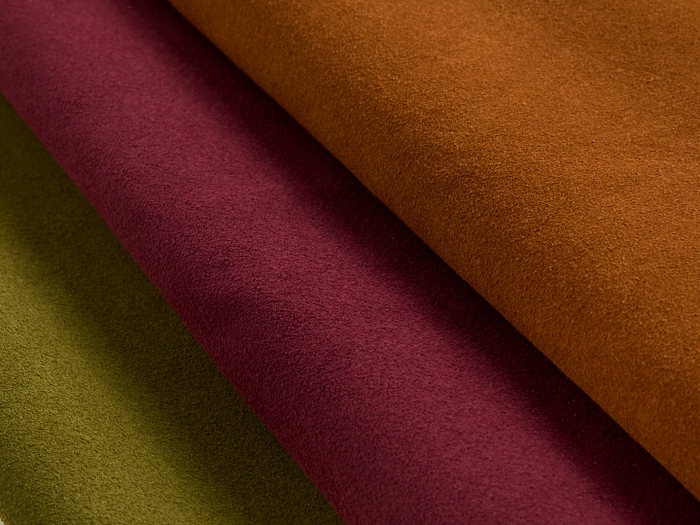How to Build Better Products with Biomaterials
Nov 01, 2024
How to Build Better Products with Biomaterials
Engineered biomaterials are designed to bridge this gap between natural materials and synthetics. They provide a consistent solution that can perform reliably across various applications. Biomaterials company, Modern Meadow, has developed Bio-VERA, a biomaterial that harnesses properties of proteins while sustainably transitioning away from virgin petrochemicals and animal-derived inputs.
Bio-VERA was designed to be stronger and lighter than leather. It is made with over 90% sustainable materials. It was created with Bio-Alloy, a flexible mix of proteins and polymers. One of its features is the ability to integrate into existing production processes used by industries such as automotive, footwear, furniture and fashion. Modern Meadow works with top brands to create fully traceable products.
We caught up with David Williamson, Modern Meadow CEO, to get his view of biomaterials and the work that Modern Meadow is doing to create sustainable products. Williamson has worked in a number or roles with technology companies such as DuPont and Kraton Polymers. He has led technological development for the past eight years across a range of fields including recombinant proteins and the development and scale up of sustainable materials.
What are biomaterials, and why should engineers be excited about working with them?
Related:Sustainable Manufacturing Expo Hits North America
Dr. David Williamson: The new class of biomaterials are redefining the way we think about product design. At their essence, biomaterials are resources derived from nature, but engineered to create high-performance materials that blend the best characteristics of natural and synthetic components. By harnessing these materials, engineers can achieve outcomes that surpass conventional alternatives, whether purely natural or synthetic.
What makes these biomaterials exciting for engineers is their unique ability to merge the aesthetics and feel of natural materials with the performance and consistency of synthetics. Natural materials can be unpredictable — their qualities can shift depending on environmental factors such as climate or soil conditions. On the other hand, synthetic materials offer reliability but often lack the tactile appeal of natural products. Engineered biomaterials bridge this gap by providing a consistently high-quality solution that performs reliably across various applications while maintaining the natural look and sensorial experience that designers and consumers love.

Fabric swaths made from biomaterials, Image courtesy of Modern Meadow
Engineers working with this material also have the advantage of contributing to a more circular design. A biomaterial is created with sustainability in mind, allowing it to be reused, recycled, and reintegrated into production cycles, which helps minimize waste. This kind of innovation is central to the future of responsible engineering.
Related:Balancing Biomaterial Strength and Degradation
How do biomaterials enhance sustainability in product development?
Williamson: Engineered biomaterials exemplify how such innovations can accelerate sustainability in product design and manufacturing. The conventional production processes in industries like automotive, fashion, and footwear can be highly resource-intensive, consuming vast amounts of water, energy, and raw materials. New biomaterials, such as our BIO-VERA, were developed to address these issues head-on.
Biomaterials offer a sustainable alternative to leather and coated textiles, reducing the environmental footprint while maintaining, and even improving, the performance standards these industries demand. By opting for this engineered solution, companies can dramatically lower their resource consumption, a crucial factor as industries face increasing pressure to adopt more sustainable practices — from both regulators and consumers.

Black auto-like swath. Image courtesy of Modern Meadow.
Beyond resource efficiency, these types of materials are designed with durability in mind, meaning products made from it have a longer lifespan, which further reduces waste. Additionally, biomaterials can be fully integrated into circular production models, enabling manufacturers to reuse and repurpose them, which contributes to a closed-loop system.
How do biomaterials improve the consistency and reliability of the materials engineers work with?
Williamson: One of the key advantages of these types of engineered materials is their consistency. While traditional natural materials can vary due to environmental factors, next-generation biomaterials are designed to offer reliable performance every time. This is critical for industries that demand precision and dependability in their materials.
For example, in automotive applications, materials must meet rigorous standards for durability, flexibility, and environmental impact. Biomaterials excel in these areas, offering a stable, high-quality option that engineers can count on to perform consistently across different production batches. Its unique manufacturing process allows for control of the material properties, ensuring it meets specific performance criteria regardless of any variability in the natural inputs.

Modern Meadow lab analasys. Image courtesy of Modern Meadow.
This consistency, combined with the ability to customize the material for different applications, makes biomaterials a preferred choice for engineers who are seeking both performance and sustainability in their designs.
What do you see as the future for biomaterials?
Williamson: The most exciting aspect of this new class of materials is that we are just beginning to unlock their full potential. Biomaterials offer an unparalleled ability to engineer their underlying structure, which means that we can push performance boundaries far beyond what is possible today. Unlike natural materials that evolve over millennia, biomaterials allow us to innovate rapidly, bypassing the slow processes of natural evolution. This accelerated timeline means we can tailor materials to specific performance needs, enhancing properties like strength, flexibility, and environmental resistance in ways nature cannot replicate on its own.
In essence, the innovation cycle with biomaterials is continuously evolving. We are not limited by the slow changes that occur in nature through evolution. Instead, we can respond to industry needs at the pace of the market, engineering the material to meet the exacting requirements of sectors like automotive, footwear, and fashion. As we refine our understanding, we can further enhance biomaterials’ properties, making them lighter, stronger, more flexible, and even more sustainable.